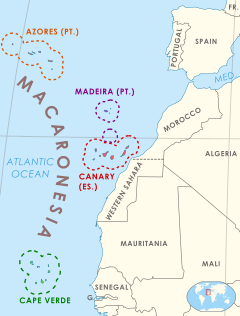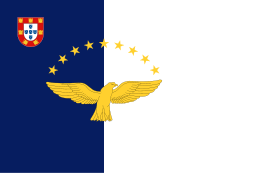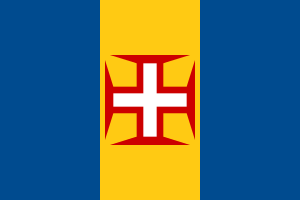Macaronesia

Macaronesia is a collection of four archipelagos in the North Atlantic Ocean off the coast of the continents of Europe and Africa. Excluding the Azores, which is considered mainly as part of Europe, the other islands of Macaronesia are closer to Africa. Macaronesian islands belong to three countries: Portugal, Spain, and Cape Verde.[1][2][3]
Etymology
The name (which is occasionally misspelled "Macronesia" in false analogy with Micronesia, an unrelated Pacific archipelago containing, among other nations, a country of the same name) is derived from the Greek words for "islands of the fortunate" μακάρων νῆσοι makárōn nêsoi, a term used by Ancient Greek geographers for islands to the west of the Straits of Gibraltar.
Archipelagos included
Macaronesia[4][5] consists of four main archipelagos; namely (north to south):
-
 Azores (
Azores ( Portugal)
Portugal) -
 Madeira (
Madeira ( Portugal), also including the Desertas Islands, Porto Santo Island, and the Selvagens Islands
Portugal), also including the Desertas Islands, Porto Santo Island, and the Selvagens Islands -
 Canary Islands (
Canary Islands ( Spain)
Spain) -
 Cape Verde (
Cape Verde ( Cape Verde)
Cape Verde)
Geography and geology
The islands of Macaronesia are volcanic in origin, and are thought to be the product of several geologic hotspots.
The climate of the Macaronesian islands ranges from Mediterranean in the Azores and Madeira to arid in certain geologically older islands of both the Canaries (Lanzarote, Fuerteventura) and Cape Verde (Sal, Boa Vista and Maio), or sub-tropical in the younger islands of both southern archipelagos (Santo Antão, Santiago and Fogo in Cape Verde, or La Palma in the Canaries). The Portuguese archipelagos of the Azores and Madeira have a generally cooler climate and higher rainfall than the Canaries and Cape Verde. The laurisilva forests of Macaronesia are a type of mountain cloud forest with relict species of a vegetation type which originally covered much of the Mediterranean Basin when the climate of the region was more humid and evolved to adapt to island conditions.
The islands have a unique biogeography, and are home to several distinct plant and animal communities. The jumping spider genus Macaroeris is named after Macaronesia. None of the Macaronesian islands were part of a continent, so the native plants and animals reached the islands via long-distance dispersal. Laurel-leaved forests, called laurisilva, once covered most of the Azores, Madeira, and parts of the Canaries between 400–1200 m altitude (the eastern Canaries and Cape Verde being too dry). These forests resemble the ancient forests that covered the Mediterranean basin and northwestern Africa before cooling and drying of the ice ages. Trees of the genera Apollonias (Lauraceae), Clethra (Clethraceae), Dracaena (Ruscaceae), Ocotea (Lauraceae), Persea (Lauraceae), and Picconia (Oleaceae), which are found in the Macaronesian laurel forests, are also known from fossil evidence to have lived around the Mediterranean before the ice ages.
Conservation issues
Felling of the forests for timber and firewood, clearing vegetation for grazing and agriculture, and the introduction of exotic plants and animals by humans has displaced much of the native vegetation. The laurisilva has been reduced to small pockets. As a result, many of the endemic biota of the islands are seriously endangered or extinct. Alien predators -- domestic and feral cats -- are one of the most serious threat to the endemic fauna. Despite the fact that cats prey mostly on introduced mammals (rodents and rabbits) this feeding sustains bigger feline populations thought to be a hyperpredation process, and that has a further impact on the endemic reptiles and birds.[6]
See also
- Category:Flora of Macaronesia
- Fortunate Isles
References
External links
| Wikimedia Commons has media related to Macaronesia. |
| ||||||||||||||||||||||
Coordinates: 24°15′24″N 22°28′16″W / 24.25667°N 22.47111°W